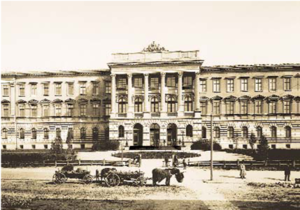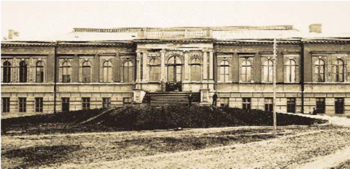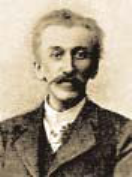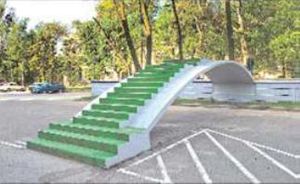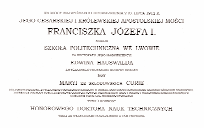Higher Polytechnic School
| Higher Polytechnic School | |
| 200px | |
| Abreviation | * |
|---|---|
| Established | 1877 |
| Liquidated | 1921 |
| Liquidation cause | Reorganisation |
| Predecessor | Technical Academy |
| Successor | Lviv Polytechnic |
The grand opening of the academic year was in the new building where rector inauguration took place on November 15, 1877: after the service in the church of St. Mary Magdalene and the consecration of the main and chemical buildings, the ceremony was held in the auditorium. Rector Yulian Zakhariyevych took a solemn lecture «Art in the service of technology».
On October 7, 1877 at the Polytechnic took place the first on the territory of the Austro-Hungarian Monarchy public lecture demonstration of a new invention - the phone.Hall of the main building was connected through two copper wires with amfi theatral audience of the Chemistry building. In the assembly hall was lecturing Associate Professor R. Hostkovskyy and in the Chemistry building - Associate Professor B.-A. Abakanowicz. The demonstration took place successfully. Many participants became convinced that talking at a distance is possible.
To facilitate research and dissemination of the results obtained in 1877 it was created the Polytechnic Society, which was publishing its own journal.
Especially for the Polytechnic a famous Polish painter Jan Matejko was commissioned to make eleven paintings that would reflect the technological progress of mankind. The artist made them as small composite sketches. In actual size pictures were painted by students of the artist: Y. Unyezhynskyy, T. Lisevych, L.Luskin Stazhenskyy and C. Luskin Stazhenskyy. The creative idea was - the cycle of paintings «The history of human civilization» allegorically reflect the path of human genius, thought, science as the basis of spiritual and technological progress, as a manifestation of human nature and results of operations of biblical principles to the end of the XIX century. These works still adorn the hall of the main building. For them Matejko received the honorary title of Doctor Honoris Causa of the Jagiellonian University in Krakow.
At the Department of Technical Chemistry opened a course of hutnytstvo (1885), the machine-building — training courses for mining professionals (1885). The Department of agriculture and forestry profession was established in 1888, Department of zoology, botany and commodity research, which was headed by prominent researcher of the flora of the Carpathians, Ukrainian Ostap Voloschak (1835-1918), in 1884. Specifically for the Roman Hostkovskoho (1837-1912) was created the Department of rail transport theory in 1890. He was the first who had this course in Austria (Professor was chairman of Polytechnic Society (1877-1884)). The department of electrical engineering was opened at the beginning of 1891. Since 1886 a research station on the problems of the oil industry and ceramics started functioning and later it did a station of mechanical testing of materials in engineering structures.
The mandatory exam rules were approved in 1878. At the end of each year the exhibitions of the best students’ works were launched. Studies were conducted in the departments of engineering, architecture, engineering and technical chemistry for free.
After two years of studying, students had general examinations in each course and after processing the entire curriculum — graduation exam, under which the graduate received the title of engineer with faculty indication (electrical engineer, chemist, etc).
The academic year has two semesters: winter — from 21 September till 31 January and the summer — from 11 February till 20 June.
At that time the four departments were training more than 250 students, half of them — at the Department of Engineering. The teaching staff consisted of 57 people.
There were 20 departments in the Polytechnic school: I Department of Mathematics and; II Department of Mathematics; Department of descriptive geometry; Department of mechanics and machines theory; Department of Geodesy and spherical astronomy; Department of physics; Department of general and analytical chemistry; Department of mineralogy and geology; Department of Architecture; II Department of Architecture; Department of Engineering (construction of roads, railways and tunnels); II Department of Engineering (water construction and engineering encyclopedia); III Department of Engineering (Theory and static construction, bridges); Theories of rail traffic; engineering; Department of Mechanical Engineering and Technology; Department of chemical engineering; Department of drawing and modeling; Department of botany, zoology and commodity; Department of Electrical Engineering. In addition to this as part of the Polytechnic school there were 19 specialized museums, 4 laboratories, 2 research stations and a library with 14 thousand of volumes.
In 1896 at the Department of Engineering was opened a two-year courses of surveyors, in 1907-1908 the Department of the aqueous separated from the Department of Engineering with the 4.5 years term of study, electrical department was established in an engineering department in 1911-1912.From the second half of the nineteenth century the Polytechnic school becomes an integral part of European technical science. Research in mechanics and theory of mechanisms was closely related to physics and mathematics. It was centered at the Polytechnic school, where Yan Francke - author of a textbook on analytical mechanics headed the Department of Mechanics (1871). Since 1908 - a talented mechanic theoretical Maximilian Huber (1872-1950). He created the foundations of theoretical and practical mechanics, formulated conditions for plasticity of materials («Huber hypothesis»), teached many students who developed research in the theory of elasticity and deformation of solids. The young physicist Tadeusz Godlevskiy (1878-1921) was the initiator of the first laboratory for studies of emitting materials in Polytechnic school. At the Department of General and Analytical Chemistry, created in 1782, he cooperated with the prominent nuclear physicist E. Rutherford.
Augustus Freund successfully investigated benzene compounds and ceramics. Professor Stephen Nementovskyy (1866-1925) headed the department in 1892. He suggested new methods of synthesis of benzemadazols that began to be used in the production of aniline dyes. Roman Zalozetskiy (1861-1918) started his scientific career in the laboratory of the department. Later he headed the laboratory. Ukrainian scientist explored oil reserves in the region, he developed a method for studying the paraffin compounds in oil, was a pioneer of geochemistry. Another Ukrainian — Julian Hirnyak (1881-1970), author of a textbook on Ukrainian chemistry for high schools (1914) started the research on chemical kinematics n the laboratory of Plytechnic school. A Ukrainian professor Julian Medvedsky (1845-1918), who was three times elected to be Rector of the Polytechnic School, began research in mineralogy and petrography of the Carpathians. Professor Dominic Zbrojek that established the Department of Geodesy in the early 1870s, developed the theory of polar planimeter and used auxiliaries in balancing ща geodetic measurements. At the Faculty of Engineering Tadeusz Fiedler (1858-1933) laid the grounds of Lviv school of technology machining of metals. Tully Maximilian (1853-1939) and Carol Skibinskyy (1849-1922) laid the grounds of school of bridge construction and structural mechanics. Built in 1892 by M. Tullius drawings with flexible outlines arched bridge, still stands on the territory of the Polytechnic. This was the first concrete piece in Lviv, which contemporaries call «frozen in the air strip». Professor Julian Zakhariyevych (1837-1898) was the founder of Lviv school of architecture. A special place in the creativty of its followers takes Ukrainian Professor John Lewinski (1851-1919) — the creator of the current Ukrainian Lviv secession, and Tadeusz Obminskyi (1874-1932) and Leonardo Marconi (1835-1899), who is the author of many sculptural compositions, Polytechnic buildings, savings bank, "George" hotel and others. At that time in the Polytechnic school teached teachers and scientists: Bruno Abakanowicz-Abdank coat of arms (1852-1900) — known as the inventor of the integrator; Professor R. Zalozetskiy, a chemistry professor Y. Medvedsky, Professor of Geology and Mineralogy, rector 1879-1880, 1884-1885, 1887-1888, Exhibition Hall (the former library). August Witkowski by design of Y. Zakhariyevych was the author of decoration — researcher of real gases; Professor L. Bodashevskyy — one of the first researchers of Brownian motion of microscopic particles; J. Richter — the first professor of hydro construction. Famous scientists of the Polytechnic, whose names are known abroad — Bogdan Marynyak (1844-1912), Vladislav Zayanchkovskyy (1837-1898), Bronislaw Pavlevskyy (1852-1917) and many others. Stefan Banach began his scientific career at the department of mathematics.The right to award the scientific degree of Doctor of Science was issued to the Polytehnic school in 1901. By 1918 there were 64 Doctors of engineering. In 1912 for services to science Maria Sklodowska-Curie was given the honorary title of Doctor Honoris Causa, Professor J. Franke, J. Medvedsky, A. Witkowski and engineer K. Obrembovychu (establisher of the Warsaw University of Technology).
In the early twentieth century Lviv becomes a significant and influential center of European science.
Sources
Presentation edition of National University «Lviv Polytechnic». Elite State «(LLC» Publishing House «Logos Ukraine», 2008). ISBN 978-966-1581-02-8
Museum of the Lviv Polytechnic. Outline and Guide. / For editorial Anna Kos. — Lviv: Publishing House of the National University "Lviv Polytechnic" 2005.
